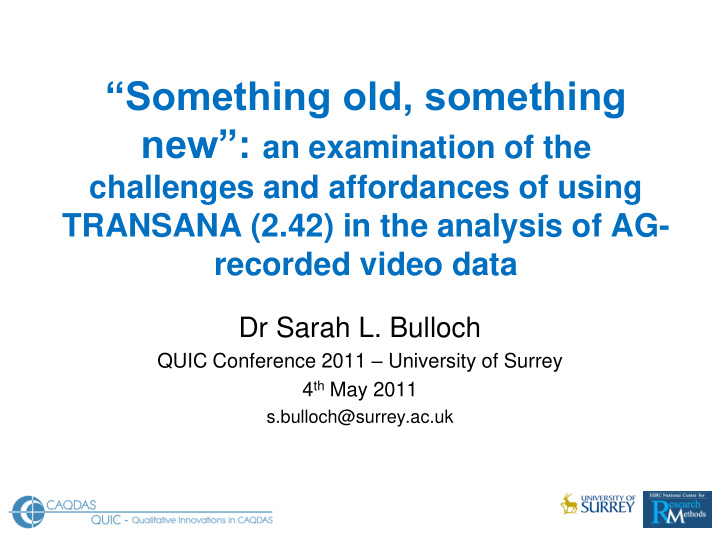



“Something old, something new”: an examination of the challenges and affordances of using TRANSANA (2.42) in the analysis of AG- recorded video data Dr Sarah L. Bulloch QUIC Conference 2011 – University of Surrey 4 th May 2011 s.bulloch@surrey.ac.uk
Outline of presentation • Overview of aims and exemplar project • What is Access Grid? • Outline of research questions • Data preparation and analytical approach • Extracts of analyses • Affordances and challenges
Aim QUIC aim: to further explore technological and methodological developments in qualitative software - audiovisual data - geographical data - integration of quantitative and qualitative data Paper aim: to examine how Transana allows us to answer particular research questions in relation to audiovisual data collected in an exemplar project
Overview of exemplar project • AG technology and field research. • Pioneered by N. Fielding and M. Macintyre, 'Access Grid Nodes in Field Research' , Sociological Research Online, 11(2), 2006. Shortlisted for the Sage Prize for Innovation and Excellence 2007. • Communication: verbal & non-verbal. • Exemplar data: business meeting, 2 AG nodes, AG- captured data AND additional video footage. • Analysis: annotating and coding sections of the video using Transana
What is Access Grid? • Real-time networked video teleconferencing application • Multiple cameras, projectors, microphones • Multiple ‘nodes’ can be linked • Desktops projected to multiple sites
How does Transana help to answer the following research questions? • Does the AG setting affect exchange between participants? If so, in what ways? • To what extent do the technical aspects (audio & visual setup) of the AG feature within the meeting? • Nuancing the notion of co-presence, does the physical grouping of individuals affect their communication? If so, how? • What are the implications of using AG-captured data for secondary analysis?
Data Preparation & analytical approach • 01:50:46 of AG captured video – captures the meeting from 9 angles (audiovisual data) • Standalone cameras. • Step 1: verbatim transcription of meeting. • Step 2: editing and preparation of video data. • Step 3: importing data into Transana • Step 4: deductive code creation • Step 5: familiarisation with data, annotation & inductive code creation (‘adaptive theory’ Layder, 1998) • Step 6: interrogating the data for answers to the research questions
Multi-stream video: AG and standalone cameras
Does the AG setting affect exchange between participants? If so, in what ways? • Multiple transcripts allow for textual representations of verbal and non-verbal exchange. e.g action transcript (movement, posture, gaze) • Flexibility in clip production in relation to what constitutes ‘an exchange’ e.g. Segments of a few minutes, speaker turns, segments of a few seconds. This project: speaker turns. • Coding for non-verbal content of audio-visual data - highlights silence, interruptions etc • Visual representation of speaker turns over time.
Coding for nature of transition of exchanges: interruptions
Episode report – filtered by keyword (interruptions)
Reviewing coded clip
Key Word Report of exchanges: by Node, meeting section and verbal interruptions AG Node 1 AG Node 2 Verbal interruptions Meeting section: Intro Meeting section: Middle Meeting section: Start
To what extent do the technical aspects of the AG technology feature within the meeting? • Multiple visuals & multiple audios • Coding of references to audio and visual set-up, – verbal and non-verbal references (Pointing at screens, searching around for appropriate screen to look at, adjusting volume of voice)
Coding for references to audio and visual aspect to the meeting
Episode report – filtered by keywords (References to technical aspects of the meeting)
Search for clips with non-verbal reference to visual set up
What are the implications of using AG- captured data for secondary analysis? • Assessing data quality: Multi-stream functionality = comparison of AG data vs non-AG data representations. • Coding of data quality issues. • Use of annotations
In-project annotations of reflections on Data Quality
Affordances and Challenges Affordances • Integration of multiple (synchronous) audiovisual data & textual data • Integration of annotations on project development • Getting at the unspoken aspects of communication Challenges • Project planning & limited flexibility • Trade off: multi-stream vs. image quality • Trade off: details vs. time • Need for textual transcript
Resources • QUIC website http://www.surrey.ac.uk/sociology/researc h/researchcentres/caqdas/quic/ • Work in progress: dissemination of the results of this analysis within wider AG work.
Recommend
More recommend